2001 DODGE RAM fuel tank capacity
[x] Cancel search: fuel tank capacityPage 19 of 2889
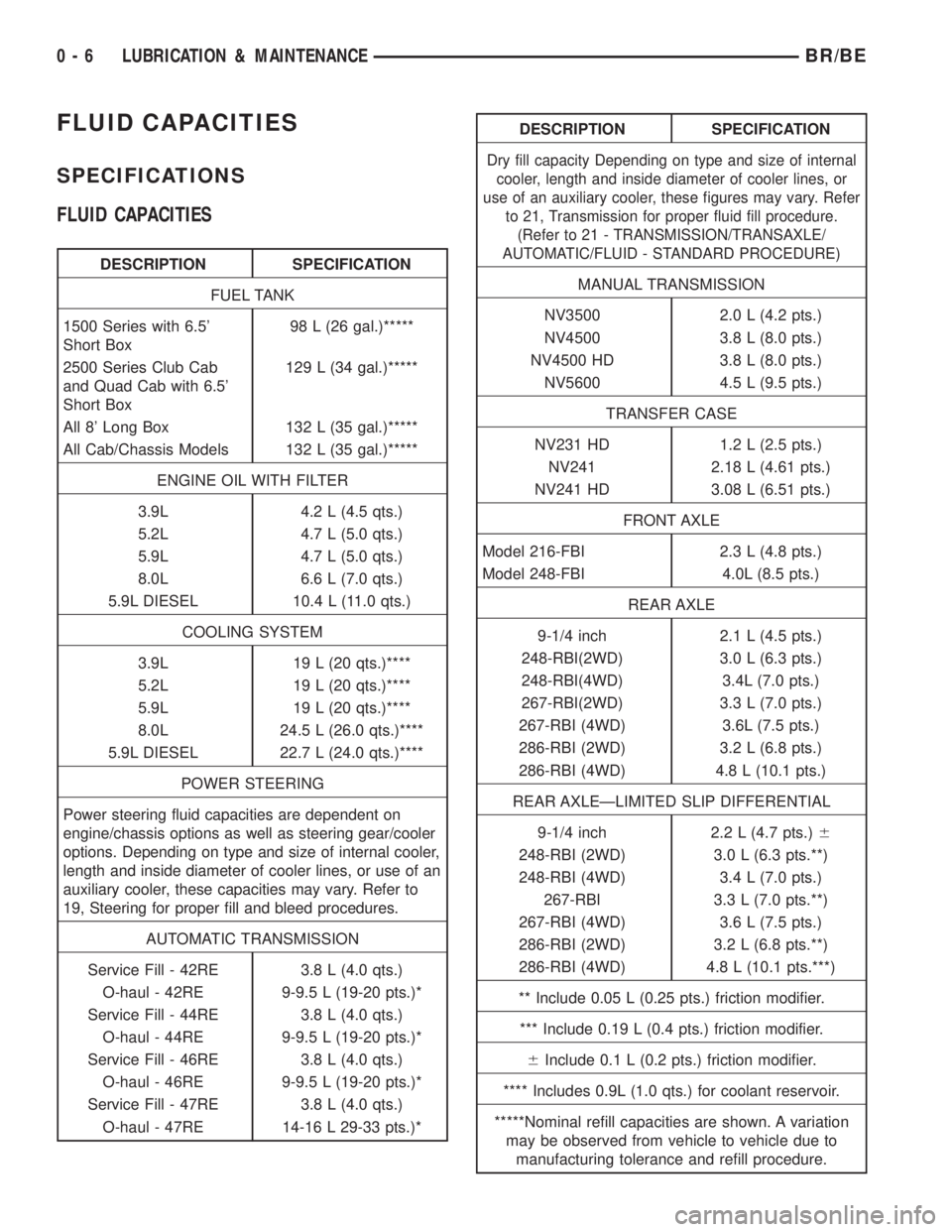
FLUID CAPACITIES
SPECIFICATIONS
FLUID CAPACITIES
DESCRIPTION SPECIFICATION
FUEL TANK
1500 Series with 6.5'
Short Box98 L (26 gal.)*****
2500 Series Club Cab
and Quad Cab with 6.5'
Short Box129 L (34 gal.)*****
All 8' Long Box 132 L (35 gal.)*****
All Cab/Chassis Models 132 L (35 gal.)*****
ENGINE OIL WITH FILTER
3.9L 4.2 L (4.5 qts.)
5.2L 4.7 L (5.0 qts.)
5.9L 4.7 L (5.0 qts.)
8.0L 6.6 L (7.0 qts.)
5.9L DIESEL 10.4 L (11.0 qts.)
COOLING SYSTEM
3.9L 19 L (20 qts.)****
5.2L 19 L (20 qts.)****
5.9L 19 L (20 qts.)****
8.0L 24.5 L (26.0 qts.)****
5.9L DIESEL 22.7 L (24.0 qts.)****
POWER STEERING
Power steering fluid capacities are dependent on
engine/chassis options as well as steering gear/cooler
options. Depending on type and size of internal cooler,
length and inside diameter of cooler lines, or use of an
auxiliary cooler, these capacities may vary. Refer to
19, Steering for proper fill and bleed procedures.
AUTOMATIC TRANSMISSION
Service Fill - 42RE 3.8 L (4.0 qts.)
O-haul - 42RE 9-9.5 L (19-20 pts.)*
Service Fill - 44RE 3.8 L (4.0 qts.)
O-haul - 44RE 9-9.5 L (19-20 pts.)*
Service Fill - 46RE 3.8 L (4.0 qts.)
O-haul - 46RE 9-9.5 L (19-20 pts.)*
Service Fill - 47RE 3.8 L (4.0 qts.)
O-haul - 47RE 14-16 L 29-33 pts.)*
DESCRIPTION SPECIFICATION
Dry fill capacity Depending on type and size of internal
cooler, length and inside diameter of cooler lines, or
use of an auxiliary cooler, these figures may vary. Refer
to 21, Transmission for proper fluid fill procedure.
(Refer to 21 - TRANSMISSION/TRANSAXLE/
AUTOMATIC/FLUID - STANDARD PROCEDURE)
MANUAL TRANSMISSION
NV3500 2.0 L (4.2 pts.)
NV4500 3.8 L (8.0 pts.)
NV4500 HD 3.8 L (8.0 pts.)
NV5600 4.5 L (9.5 pts.)
TRANSFER CASE
NV231 HD 1.2 L (2.5 pts.)
NV241 2.18 L (4.61 pts.)
NV241 HD 3.08 L (6.51 pts.)
FRONT AXLE
Model 216-FBI 2.3 L (4.8 pts.)
Model 248-FBI 4.0L (8.5 pts.)
REAR AXLE
9-1/4 inch 2.1 L (4.5 pts.)
248-RBI(2WD) 3.0 L (6.3 pts.)
248-RBI(4WD) 3.4L (7.0 pts.)
267-RBI(2WD) 3.3 L (7.0 pts.)
267-RBI (4WD) 3.6L (7.5 pts.)
286-RBI (2WD) 3.2 L (6.8 pts.)
286-RBI (4WD) 4.8 L (10.1 pts.)
REAR AXLEÐLIMITED SLIP DIFFERENTIAL
9-1/4 inch 2.2 L (4.7 pts.)6
248-RBI (2WD) 3.0 L (6.3 pts.**)
248-RBI (4WD) 3.4 L (7.0 pts.)
267-RBI 3.3 L (7.0 pts.**)
267-RBI (4WD) 3.6 L (7.5 pts.)
286-RBI (2WD) 3.2 L (6.8 pts.**)
286-RBI (4WD) 4.8 L (10.1 pts.***)
** Include 0.05 L (0.25 pts.) friction modifier.
*** Include 0.19 L (0.4 pts.) friction modifier.
6Include 0.1 L (0.2 pts.) friction modifier.
**** Includes 0.9L (1.0 qts.) for coolant reservoir.
*****Nominal refill capacities are shown. A variation
may be observed from vehicle to vehicle due to
manufacturing tolerance and refill procedure.
0 - 6 LUBRICATION & MAINTENANCEBR/BE
Page 1488 of 2889
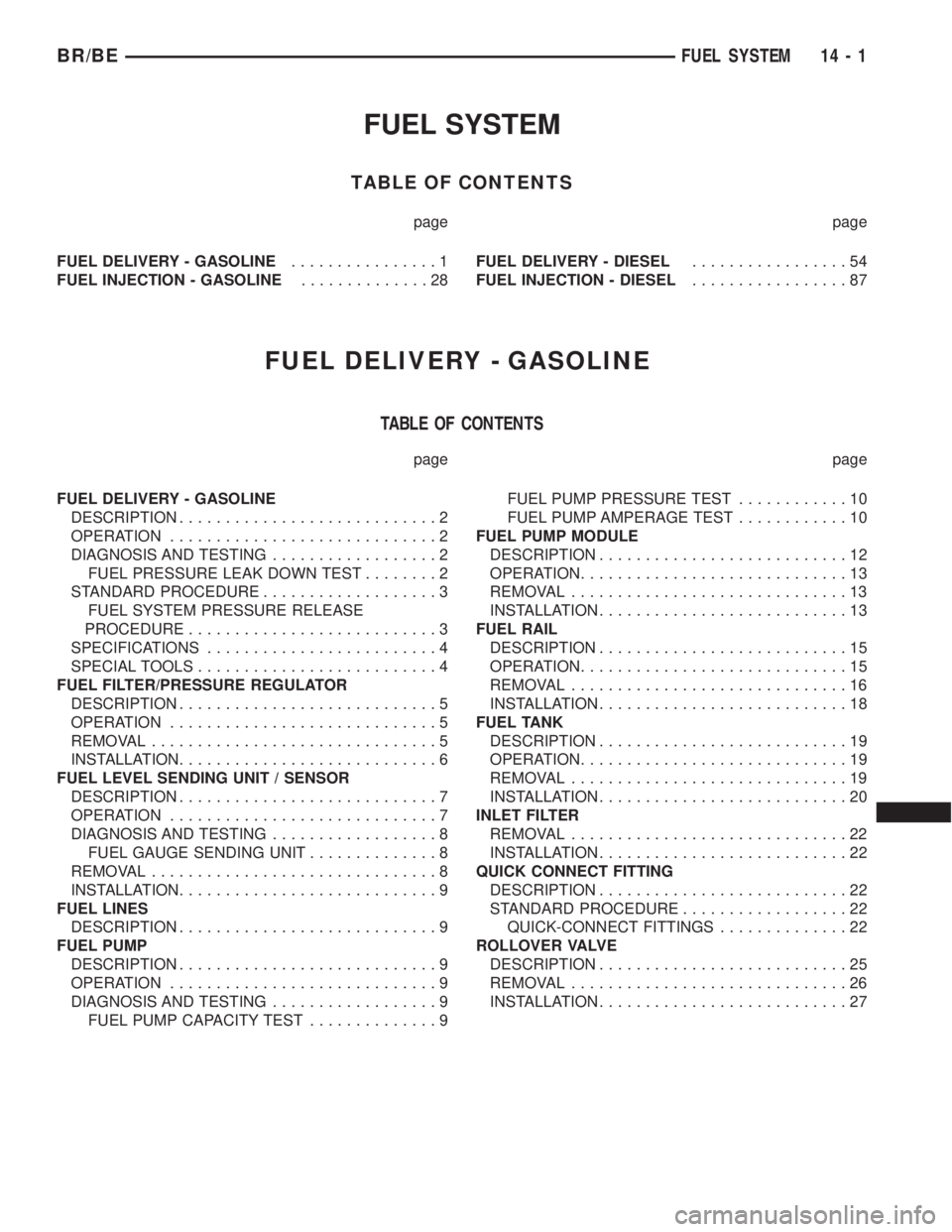
FUEL SYSTEM
TABLE OF CONTENTS
page page
FUEL DELIVERY - GASOLINE................1
FUEL INJECTION - GASOLINE..............28FUEL DELIVERY - DIESEL.................54
FUEL INJECTION - DIESEL.................87
FUEL DELIVERY - GASOLINE
TABLE OF CONTENTS
page page
FUEL DELIVERY - GASOLINE
DESCRIPTION............................2
OPERATION.............................2
DIAGNOSIS AND TESTING..................2
FUEL PRESSURE LEAK DOWN TEST........2
STANDARD PROCEDURE...................3
FUEL SYSTEM PRESSURE RELEASE
PROCEDURE...........................3
SPECIFICATIONS.........................4
SPECIAL TOOLS..........................4
FUEL FILTER/PRESSURE REGULATOR
DESCRIPTION............................5
OPERATION.............................5
REMOVAL...............................5
INSTALLATION............................6
FUEL LEVEL SENDING UNIT / SENSOR
DESCRIPTION............................7
OPERATION.............................7
DIAGNOSIS AND TESTING..................8
FUEL GAUGE SENDING UNIT..............8
REMOVAL...............................8
INSTALLATION............................9
FUEL LINES
DESCRIPTION............................9
FUEL PUMP
DESCRIPTION............................9
OPERATION.............................9
DIAGNOSIS AND TESTING..................9
FUEL PUMP CAPACITY TEST..............9FUEL PUMP PRESSURE TEST............10
FUEL PUMP AMPERAGE TEST............10
FUEL PUMP MODULE
DESCRIPTION...........................12
OPERATION.............................13
REMOVAL..............................13
INSTALLATION...........................13
FUEL RAIL
DESCRIPTION...........................15
OPERATION.............................15
REMOVAL..............................16
INSTALLATION...........................18
FUEL TANK
DESCRIPTION...........................19
OPERATION.............................19
REMOVAL..............................19
INSTALLATION...........................20
INLET FILTER
REMOVAL..............................22
INSTALLATION...........................22
QUICK CONNECT FITTING
DESCRIPTION...........................22
STANDARD PROCEDURE..................22
QUICK-CONNECT FITTINGS..............22
ROLLOVER VALVE
DESCRIPTION...........................25
REMOVAL..............................26
INSTALLATION...........................27
BR/BEFUEL SYSTEM 14 - 1
Page 1489 of 2889
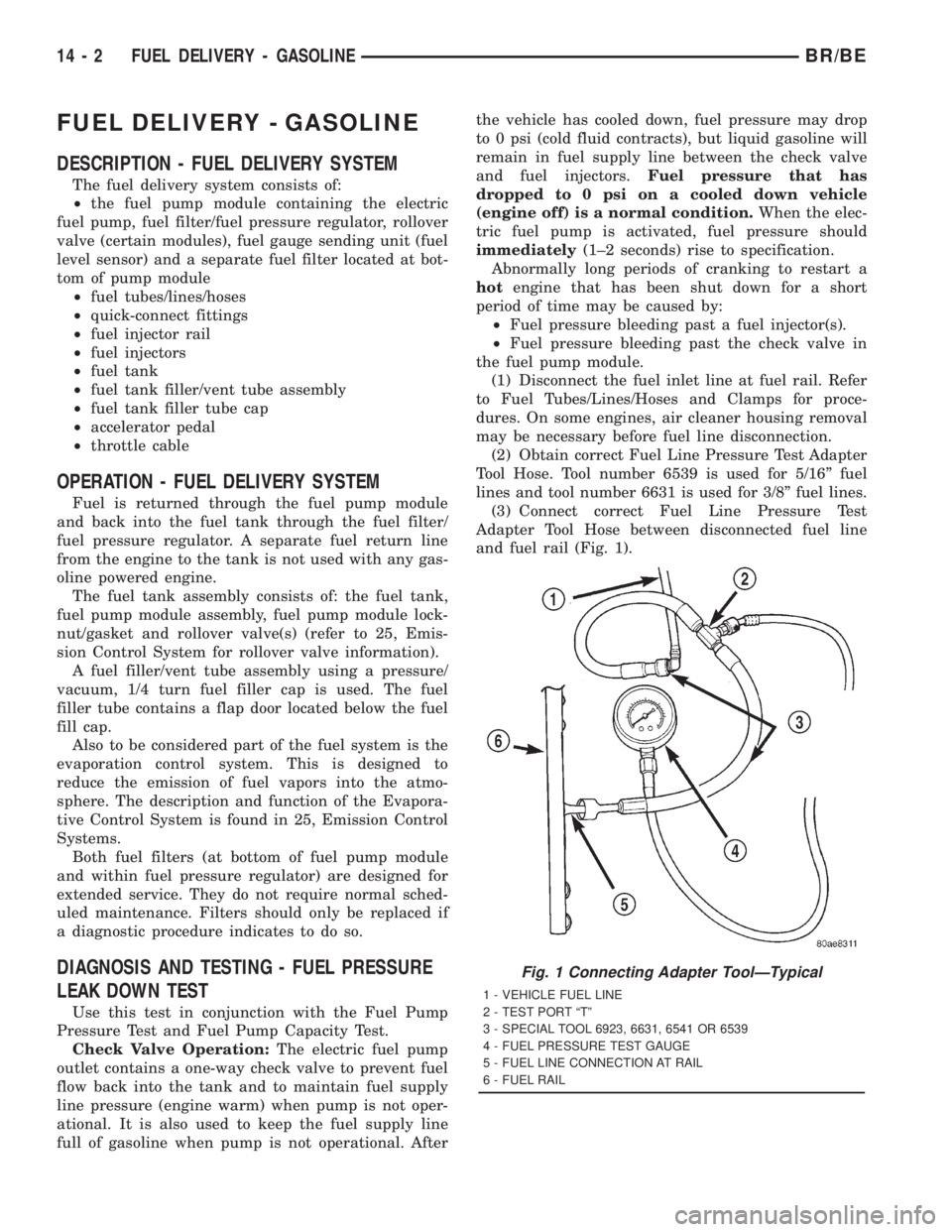
FUEL DELIVERY - GASOLINE
DESCRIPTION - FUEL DELIVERY SYSTEM
The fuel delivery system consists of:
²the fuel pump module containing the electric
fuel pump, fuel filter/fuel pressure regulator, rollover
valve (certain modules), fuel gauge sending unit (fuel
level sensor) and a separate fuel filter located at bot-
tom of pump module
²fuel tubes/lines/hoses
²quick-connect fittings
²fuel injector rail
²fuel injectors
²fuel tank
²fuel tank filler/vent tube assembly
²fuel tank filler tube cap
²accelerator pedal
²throttle cable
OPERATION - FUEL DELIVERY SYSTEM
Fuel is returned through the fuel pump module
and back into the fuel tank through the fuel filter/
fuel pressure regulator. A separate fuel return line
from the engine to the tank is not used with any gas-
oline powered engine.
The fuel tank assembly consists of: the fuel tank,
fuel pump module assembly, fuel pump module lock-
nut/gasket and rollover valve(s) (refer to 25, Emis-
sion Control System for rollover valve information).
A fuel filler/vent tube assembly using a pressure/
vacuum, 1/4 turn fuel filler cap is used. The fuel
filler tube contains a flap door located below the fuel
fill cap.
Also to be considered part of the fuel system is the
evaporation control system. This is designed to
reduce the emission of fuel vapors into the atmo-
sphere. The description and function of the Evapora-
tive Control System is found in 25, Emission Control
Systems.
Both fuel filters (at bottom of fuel pump module
and within fuel pressure regulator) are designed for
extended service. They do not require normal sched-
uled maintenance. Filters should only be replaced if
a diagnostic procedure indicates to do so.
DIAGNOSIS AND TESTING - FUEL PRESSURE
LEAK DOWN TEST
Use this test in conjunction with the Fuel Pump
Pressure Test and Fuel Pump Capacity Test.
Check Valve Operation:The electric fuel pump
outlet contains a one-way check valve to prevent fuel
flow back into the tank and to maintain fuel supply
line pressure (engine warm) when pump is not oper-
ational. It is also used to keep the fuel supply line
full of gasoline when pump is not operational. Afterthe vehicle has cooled down, fuel pressure may drop
to 0 psi (cold fluid contracts), but liquid gasoline will
remain in fuel supply line between the check valve
and fuel injectors.Fuel pressure that has
dropped to 0 psi on a cooled down vehicle
(engine off) is a normal condition.When the elec-
tric fuel pump is activated, fuel pressure should
immediately(1±2 seconds) rise to specification.
Abnormally long periods of cranking to restart a
hotengine that has been shut down for a short
period of time may be caused by:
²Fuel pressure bleeding past a fuel injector(s).
²Fuel pressure bleeding past the check valve in
the fuel pump module.
(1) Disconnect the fuel inlet line at fuel rail. Refer
to Fuel Tubes/Lines/Hoses and Clamps for proce-
dures. On some engines, air cleaner housing removal
may be necessary before fuel line disconnection.
(2) Obtain correct Fuel Line Pressure Test Adapter
Tool Hose. Tool number 6539 is used for 5/16º fuel
lines and tool number 6631 is used for 3/8º fuel lines.
(3) Connect correct Fuel Line Pressure Test
Adapter Tool Hose between disconnected fuel line
and fuel rail (Fig. 1).
Fig. 1 Connecting Adapter ToolÐTypical
1 - VEHICLE FUEL LINE
2 - TEST PORT ªTº
3 - SPECIAL TOOL 6923, 6631, 6541 OR 6539
4 - FUEL PRESSURE TEST GAUGE
5 - FUEL LINE CONNECTION AT RAIL
6 - FUEL RAIL
14 - 2 FUEL DELIVERY - GASOLINEBR/BE
Page 1495 of 2889

Both of the electrical circuits between the fuel
gauge sending unit and the PCM are hard-wired (not
multi-plexed). After the voltage signal is sent from
the resistor track, and back to the PCM, the PCM
will interpret the resistance (voltage) data and send
a message across the multi-plex bus circuits to the
instrument panel cluster. Here it is translated into
the appropriate fuel gauge level reading. Refer to
Instrument Panel for additional information.
For OBD II Emission Monitor Requirements:
The PCM will monitor the voltage output sent from
the resistor track on the sending unit to indicate fuel
level. The purpose of this feature is to prevent the
OBD II system from recording/setting false misfire
and fuel system monitor diagnostic trouble codes.
The feature is activated if the fuel level in the tank
is less than approximately 15 percent of its rated
capacity. If equipped with a Leak Detection Pump
(EVAP system monitor), this feature will also be acti-
vated if the fuel level in the tank is more than
approximately 85 percent of its rated capacity.
DIAGNOSIS AND TESTING - FUEL GAUGE
SENDING UNIT
The fuel gauge sending unit contains a variable
resistor (track). As the float moves up or down, elec-
trical resistance will change. Refer to 8, Instrument
Panel and Gauges for Fuel Gauge testing. To test the
gauge sending unit only, it must be removed from
vehicle. The unit is part of the fuel pump module.
Refer to Fuel Pump Module Removal/Installation for
procedures. Measure the resistance across the send-
ing unit terminals. With float in up position, resis-
tance should be 20 ohms66 ohms. With float in
down position, resistance should be 220 ohms66
ohms.
REMOVAL
The fuel gauge sending unit (fuel level sensor) and
float assembly is located on the side of fuel pump
module (Fig. 9). The fuel pump module is located
inside of fuel tank.
(1) Remove fuel tank. Refer to Fuel Tank±All
Engines in the Removal/Installation section.
(2) Remove fuel pump module. Refer to Fuel Pump
Module Removal/Installation.
(3) Unplug 4±way electrical connector (Fig. 9).
(4) Disconnect 2 sending unit wires at 4±way con-
nector. The locking collar of connector must be
removed before wires can be released from connector.
Note location of wires within 4±way connector.
(5) The sending unit is retained to pump module
with a small lock tab and notch (Fig. 10). Carefully
push lock tab to the side and away from notch while
sliding sending unit downward on tracks for removal.
Note wire routing while removing unit from module.
Fig. 9 Fuel Gauge Sending Unit LocationÐTYPICAL
Module
1 - FUEL FILTER/PRESSURE REGULATOR
2 - ELECTRICAL CONNECTOR
3 - ELECTRIC FUEL PUMP
4 - FUEL GAUGE FLOAT
5 - FUEL PUMP INLET FILTER
6 - FUEL GAUGE SENDING UNIT
7 - MODULE LOCK TABS (3)
Fig. 10 Fuel Gauge Sending Unit Lock Tab/Tracks
1 - FUEL GAUGE SENDING UNIT
2 - LOCK TAB
3 - NOTCH
4 - TRACKS
14 - 8 FUEL DELIVERY - GASOLINEBR/BE
FUEL LEVEL SENDING UNIT / SENSOR (Continued)
Page 1496 of 2889
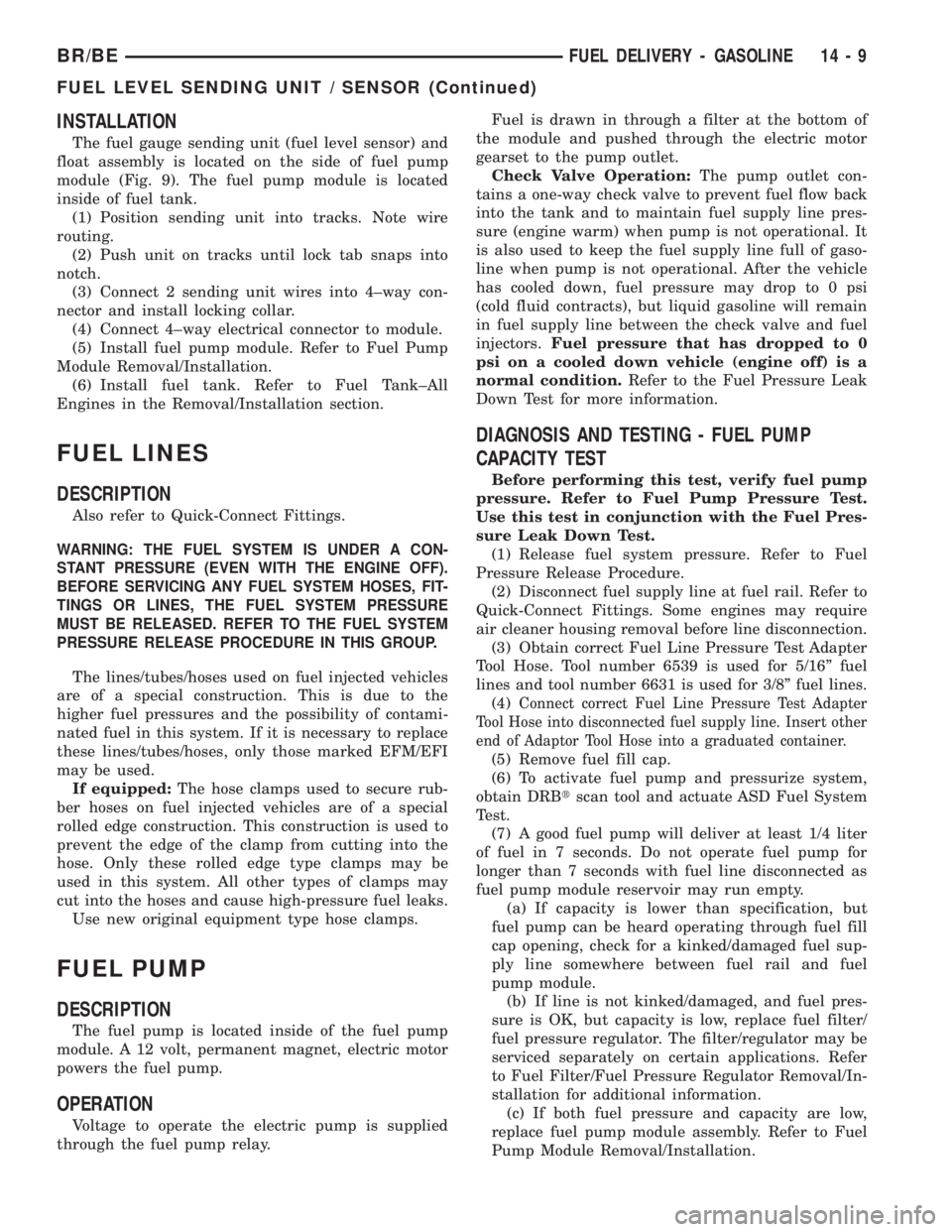
INSTALLATION
The fuel gauge sending unit (fuel level sensor) and
float assembly is located on the side of fuel pump
module (Fig. 9). The fuel pump module is located
inside of fuel tank.
(1) Position sending unit into tracks. Note wire
routing.
(2) Push unit on tracks until lock tab snaps into
notch.
(3) Connect 2 sending unit wires into 4±way con-
nector and install locking collar.
(4) Connect 4±way electrical connector to module.
(5) Install fuel pump module. Refer to Fuel Pump
Module Removal/Installation.
(6) Install fuel tank. Refer to Fuel Tank±All
Engines in the Removal/Installation section.
FUEL LINES
DESCRIPTION
Also refer to Quick-Connect Fittings.
WARNING: THE FUEL SYSTEM IS UNDER A CON-
STANT PRESSURE (EVEN WITH THE ENGINE OFF).
BEFORE SERVICING ANY FUEL SYSTEM HOSES, FIT-
TINGS OR LINES, THE FUEL SYSTEM PRESSURE
MUST BE RELEASED. REFER TO THE FUEL SYSTEM
PRESSURE RELEASE PROCEDURE IN THIS GROUP.
The lines/tubes/hoses used on fuel injected vehicles
are of a special construction. This is due to the
higher fuel pressures and the possibility of contami-
nated fuel in this system. If it is necessary to replace
these lines/tubes/hoses, only those marked EFM/EFI
may be used.
If equipped:The hose clamps used to secure rub-
ber hoses on fuel injected vehicles are of a special
rolled edge construction. This construction is used to
prevent the edge of the clamp from cutting into the
hose. Only these rolled edge type clamps may be
used in this system. All other types of clamps may
cut into the hoses and cause high-pressure fuel leaks.
Use new original equipment type hose clamps.
FUEL PUMP
DESCRIPTION
The fuel pump is located inside of the fuel pump
module. A 12 volt, permanent magnet, electric motor
powers the fuel pump.
OPERATION
Voltage to operate the electric pump is supplied
through the fuel pump relay.Fuel is drawn in through a filter at the bottom of
the module and pushed through the electric motor
gearset to the pump outlet.
Check Valve Operation:The pump outlet con-
tains a one-way check valve to prevent fuel flow back
into the tank and to maintain fuel supply line pres-
sure (engine warm) when pump is not operational. It
is also used to keep the fuel supply line full of gaso-
line when pump is not operational. After the vehicle
has cooled down, fuel pressure may drop to 0 psi
(cold fluid contracts), but liquid gasoline will remain
in fuel supply line between the check valve and fuel
injectors.Fuel pressure that has dropped to 0
psi on a cooled down vehicle (engine off) is a
normal condition.Refer to the Fuel Pressure Leak
Down Test for more information.
DIAGNOSIS AND TESTING - FUEL PUMP
CAPACITY TEST
Before performing this test, verify fuel pump
pressure. Refer to Fuel Pump Pressure Test.
Use this test in conjunction with the Fuel Pres-
sure Leak Down Test.
(1) Release fuel system pressure. Refer to Fuel
Pressure Release Procedure.
(2) Disconnect fuel supply line at fuel rail. Refer to
Quick-Connect Fittings. Some engines may require
air cleaner housing removal before line disconnection.
(3) Obtain correct Fuel Line Pressure Test Adapter
Tool Hose. Tool number 6539 is used for 5/16º fuel
lines and tool number 6631 is used for 3/8º fuel lines.
(4)
Connect correct Fuel Line Pressure Test Adapter
Tool Hose into disconnected fuel supply line. Insert other
end of Adaptor Tool Hose into a graduated container.
(5) Remove fuel fill cap.
(6) To activate fuel pump and pressurize system,
obtain DRBtscan tool and actuate ASD Fuel System
Test.
(7) A good fuel pump will deliver at least 1/4 liter
of fuel in 7 seconds. Do not operate fuel pump for
longer than 7 seconds with fuel line disconnected as
fuel pump module reservoir may run empty.
(a) If capacity is lower than specification, but
fuel pump can be heard operating through fuel fill
cap opening, check for a kinked/damaged fuel sup-
ply line somewhere between fuel rail and fuel
pump module.
(b) If line is not kinked/damaged, and fuel pres-
sure is OK, but capacity is low, replace fuel filter/
fuel pressure regulator. The filter/regulator may be
serviced separately on certain applications. Refer
to Fuel Filter/Fuel Pressure Regulator Removal/In-
stallation for additional information.
(c) If both fuel pressure and capacity are low,
replace fuel pump module assembly. Refer to Fuel
Pump Module Removal/Installation.
BR/BEFUEL DELIVERY - GASOLINE 14 - 9
FUEL LEVEL SENDING UNIT / SENSOR (Continued)
Page 1497 of 2889

DIAGNOSIS AND TESTING - FUEL PUMP
PRESSURE TEST
Use this test in conjunction with the Fuel Pump
Capacity Test, Fuel Pressure Leak Down Test and Fuel
Pump Amperage Test found elsewhere in this group.
Check Valve Operation:The electric fuel pump
outlet contains a one-way check valve to prevent fuel
flow back into the tank and to maintain fuel supply
line pressure (engine warm) when pump is not oper-
ational. It is also used to keep the fuel supply line
full of gasoline when pump is not operational. After
the vehicle has cooled down, fuel pressure may drop
to 0 psi (cold fluid contracts), but liquid gasoline will
remain in fuel supply line between the check valve
and fuel injectors.Fuel pressure that has
dropped to 0 psi on a cooled down vehicle
(engine off) is a normal condition.When the elec-
tric fuel pump is activated, fuel pressure should
immediately(1±2 seconds) rise to specification.
All fuel systems are equipped with a fuel tank
module mounted, combination fuel filter/fuel pressure
regulator. The fuel pressure regulator is not con-
trolled by engine vacuum.
WARNING: THE FUEL SYSTEM IS UNDER CON-
STANT FUEL PRESSURE EVEN WITH THE ENGINE
OFF. BEFORE DISCONNECTING FUEL LINE AT
FUEL RAIL, THIS PRESSURE MUST BE RELEASED.
REFER TO THE FUEL SYSTEM PRESSURE
RELEASE PROCEDURE.
(1) Remove protective cap at fuel rail test port.
Connect the 0±414 kPa (0-60 psi) fuel pressure gauge
(from gauge set 5069) to test port pressure fitting on
fuel rail (Fig. 11).The DRBtIII Scan Tool along
with the PEP module, the 500 psi pressure
transducer, and the transducer-to-test port
adapter may also be used in place of the fuel
pressure gauge.
(2) Start and warm engine and note pressure
gauge reading. Fuel pressure should be 339 kPa634
kPa (49.2 psi65 psi) at idle.
(3) If engine runs, but pressure is below 44.2 psi,
check for a kinked fuel supply line somewhere
between fuel rail and fuel pump module. If line is not
kinked, but specifications for either the Fuel Pump
Capacity, Fuel Pump Amperage or Fuel Pressure
Leak Down Tests were not met, replace fuel pump
module assembly. Refer to Fuel Pump Module
Removal/Installation.
(4) If operating pressure is above 54.2 psi, electric
fuel pump is OK, but fuel pressure regulator is defec-
tive. Replace fuel filter/fuel pressure regulator. Refer
to Fuel Filter/Fuel Pressure Regulator Removal/In-
stallation for more information.
(5) Install protective cap to fuel rail test port.
DIAGNOSIS AND TESTING - FUEL PUMP
AMPERAGE TEST
This amperage (current draw) test is to be done in
conjunction with the Fuel Pump Pressure Test, Fuel
Pump Capacity Test and Fuel Pressure Leak Down
Test. Before performing the amperage test, be sure the
temperature of the fuel tank is above 50É F (10É C).
The DRBtScan Tool along with the DRB Low Cur-
rent Shunt (LCS) adapter (Fig. 12) and its test leads
will be used to check fuel pump amperage specifications.
Fig. 11 Fuel Pressure Test Gauge (Typical Gauge
Installation at Test Port)
1 - SERVICE (TEST) PORT
2 - FUEL PRESSURE TEST GAUGE
3 - FUEL RAIL
Fig. 12 Low Current Shunt
1 - LOW CURRENT SHUNT ADAPTER
2 - PLUG TO DRB
3 - TEST LEAD RECEPTACLES
14 - 10 FUEL DELIVERY - GASOLINEBR/BE
FUEL PUMP (Continued)
Page 1499 of 2889
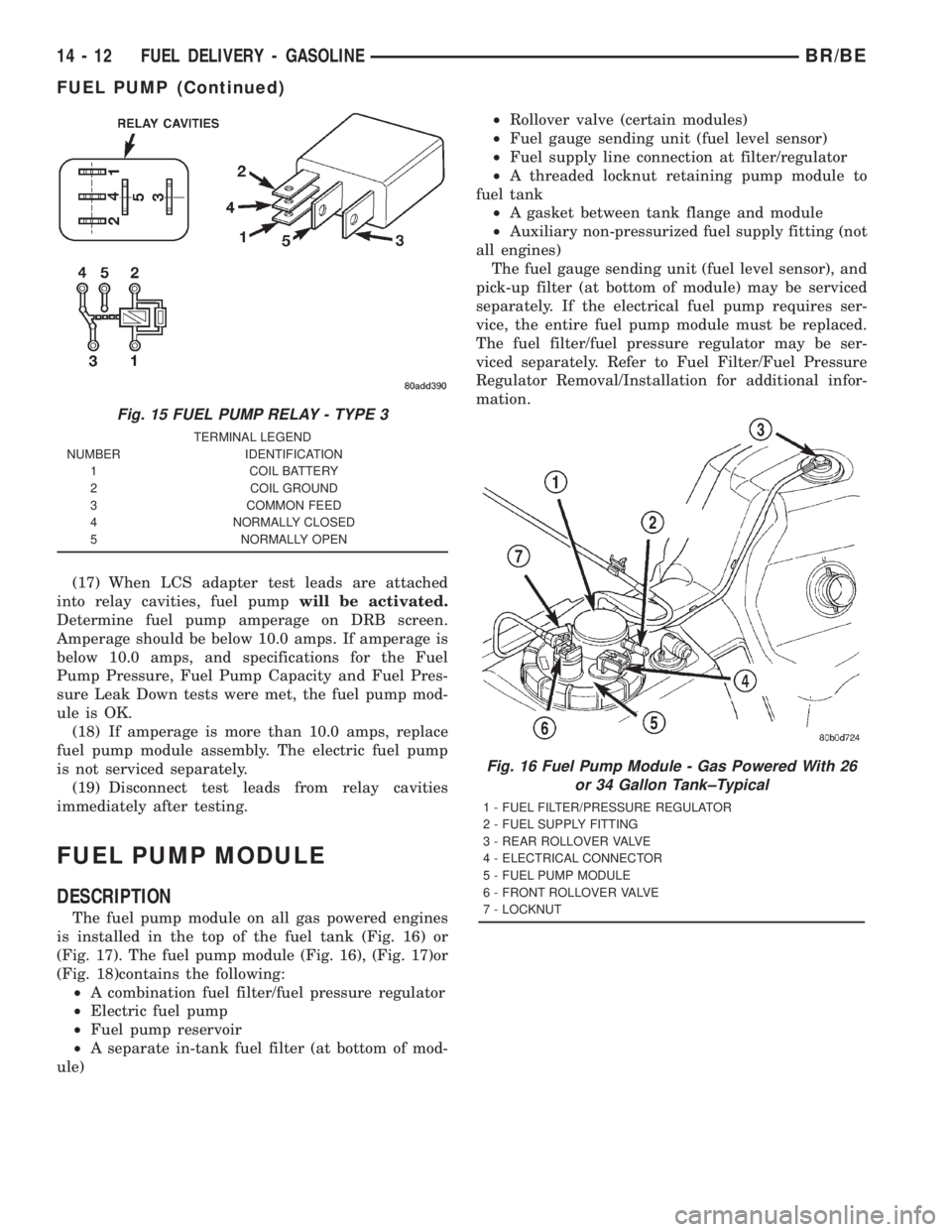
(17) When LCS adapter test leads are attached
into relay cavities, fuel pumpwill be activated.
Determine fuel pump amperage on DRB screen.
Amperage should be below 10.0 amps. If amperage is
below 10.0 amps, and specifications for the Fuel
Pump Pressure, Fuel Pump Capacity and Fuel Pres-
sure Leak Down tests were met, the fuel pump mod-
ule is OK.
(18) If amperage is more than 10.0 amps, replace
fuel pump module assembly. The electric fuel pump
is not serviced separately.
(19) Disconnect test leads from relay cavities
immediately after testing.
FUEL PUMP MODULE
DESCRIPTION
The fuel pump module on all gas powered engines
is installed in the top of the fuel tank (Fig. 16) or
(Fig. 17). The fuel pump module (Fig. 16), (Fig. 17)or
(Fig. 18)contains the following:
²A combination fuel filter/fuel pressure regulator
²Electric fuel pump
²Fuel pump reservoir
²A separate in-tank fuel filter (at bottom of mod-
ule)²Rollover valve (certain modules)
²Fuel gauge sending unit (fuel level sensor)
²Fuel supply line connection at filter/regulator
²A threaded locknut retaining pump module to
fuel tank
²A gasket between tank flange and module
²Auxiliary non-pressurized fuel supply fitting (not
all engines)
The fuel gauge sending unit (fuel level sensor), and
pick-up filter (at bottom of module) may be serviced
separately. If the electrical fuel pump requires ser-
vice, the entire fuel pump module must be replaced.
The fuel filter/fuel pressure regulator may be ser-
viced separately. Refer to Fuel Filter/Fuel Pressure
Regulator Removal/Installation for additional infor-
mation.
Fig. 15 FUEL PUMP RELAY - TYPE 3
TERMINAL LEGEND
NUMBER IDENTIFICATION
1 COIL BATTERY
2 COIL GROUND
3 COMMON FEED
4 NORMALLY CLOSED
5 NORMALLY OPEN
Fig. 16 Fuel Pump Module - Gas Powered With 26
or 34 Gallon Tank±Typical
1 - FUEL FILTER/PRESSURE REGULATOR
2 - FUEL SUPPLY FITTING
3 - REAR ROLLOVER VALVE
4 - ELECTRICAL CONNECTOR
5 - FUEL PUMP MODULE
6 - FRONT ROLLOVER VALVE
7 - LOCKNUT
14 - 12 FUEL DELIVERY - GASOLINEBR/BE
FUEL PUMP (Continued)
Page 2862 of 2889
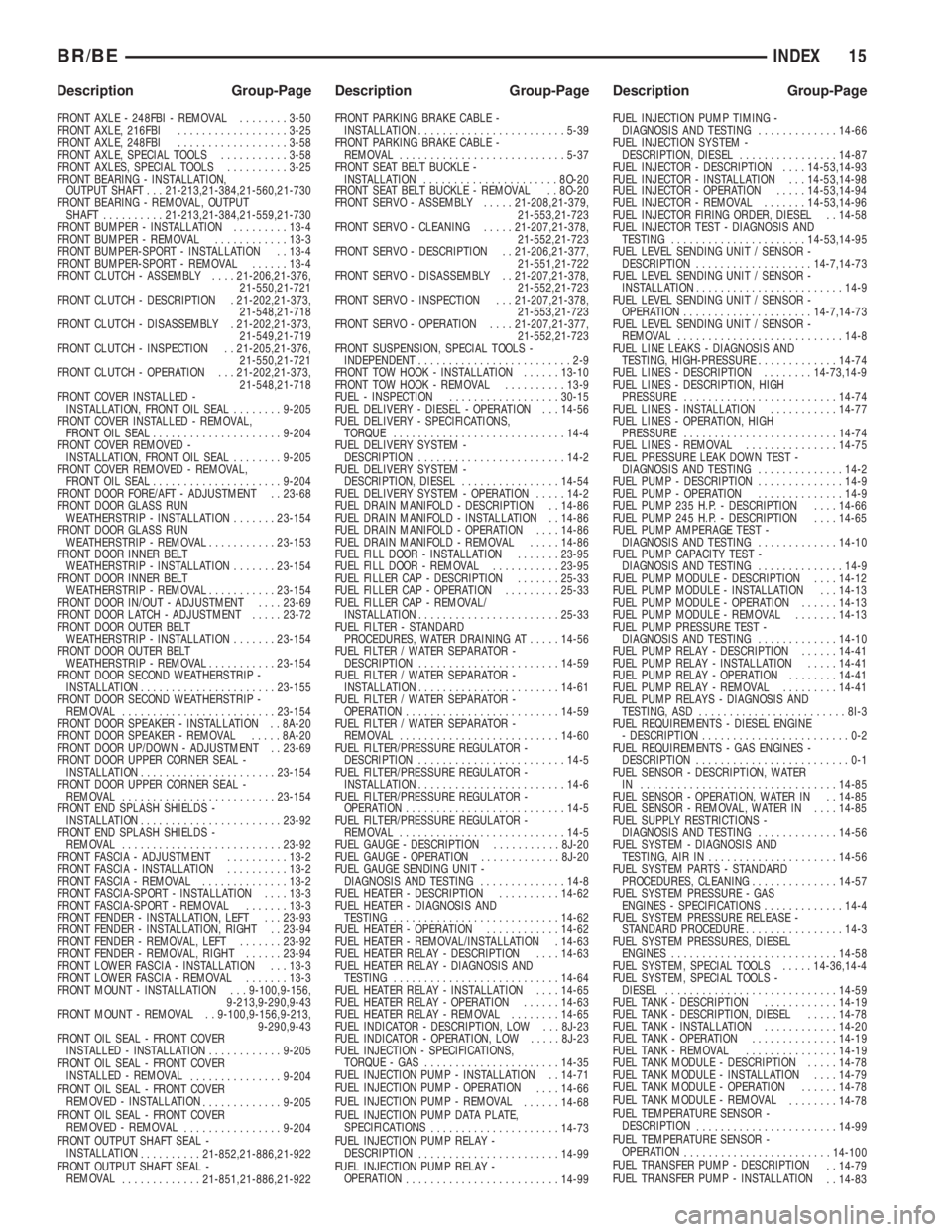
FRONT AXLE - 248FBI - REMOVAL........3-50
FRONT AXLE, 216FBI..................3-25
FRONT AXLE, 248FBI..................3-58
FRONT AXLE, SPECIAL TOOLS...........3-58
FRONT AXLES, SPECIAL TOOLS..........3-25
FRONT BEARING - INSTALLATION,
OUTPUT SHAFT . . . 21-213,21-384,21-560,21-730
FRONT BEARING - REMOVAL, OUTPUT
SHAFT..........21-213,21-384,21-559,21-730
FRONT BUMPER - INSTALLATION.........13-4
FRONT BUMPER - REMOVAL............13-3
FRONT BUMPER-SPORT - INSTALLATION . . 13-4
FRONT BUMPER-SPORT - REMOVAL......13-4
FRONT CLUTCH - ASSEMBLY....21-206,21-376,
21-550,21-721
FRONT CLUTCH - DESCRIPTION . 21-202,21-373,
21-548,21-718
FRONT CLUTCH - DISASSEMBLY . 21-202,21-373,
21-549,21-719
FRONT CLUTCH - INSPECTION . . 21-205,21-376,
21-550,21-721
FRONT CLUTCH - OPERATION . . . 21-202,21-373,
21-548,21-718
FRONT COVER INSTALLED -
INSTALLATION, FRONT OIL SEAL........9-205
FRONT COVER INSTALLED - REMOVAL,
FRONT OIL SEAL.....................9-204
FRONT COVER REMOVED -
INSTALLATION, FRONT OIL SEAL........9-205
FRONT COVER REMOVED - REMOVAL,
FRONT OIL SEAL......................9-204
FRONT DOOR FORE/AFT - ADJUSTMENT . . 23-68
FRONT DOOR GLASS RUN
WEATHERSTRIP - INSTALLATION.......23-154
FRONT DOOR GLASS RUN
WEATHERSTRIP - REMOVAL...........23-153
FRONT DOOR INNER BELT
WEATHERSTRIP - INSTALLATION.......23-154
FRONT DOOR INNER BELT
WEATHERSTRIP - REMOVAL...........23-154
FRONT DOOR IN/OUT - ADJUSTMENT....23-69
FRONT DOOR LATCH - ADJUSTMENT.....23-72
FRONT DOOR OUTER BELT
WEATHERSTRIP - INSTALLATION.......23-154
FRONT DOOR OUTER BELT
WEATHERSTRIP - REMOVAL...........23-154
FRONT DOOR SECOND WEATHERSTRIP -
INSTALLATION......................23-155
FRONT DOOR SECOND WEATHERSTRIP -
REMOVAL.........................23-154
FRONT DOOR SPEAKER - INSTALLATION . . 8A-20
FRONT DOOR SPEAKER - REMOVAL.....8A-20
FRONT DOOR UP/DOWN - ADJUSTMENT . . 23-69
FRONT DOOR UPPER CORNER SEAL -
INSTALLATION......................23-154
FRONT DOOR UPPER CORNER SEAL -
REMOVAL.........................23-154
FRONT END SPLASH SHIELDS -
INSTALLATION.......................23-92
FRONT END SPLASH SHIELDS -
REMOVAL..........................23-92
FRONT FASCIA - ADJUSTMENT..........13-2
FRONT FASCIA - INSTALLATION..........13-2
FRONT FASCIA - REMOVAL..............13-2
FRONT FASCIA-SPORT - INSTALLATION....13-3
FRONT FASCIA-SPORT - REMOVAL.......13-3
FRONT FENDER - INSTALLATION, LEFT . . . 23-93
FRONT FENDER - INSTALLATION, RIGHT . . 23-94
FRONT FENDER - REMOVAL, LEFT.......23-92
FRONT FENDER - REMOVAL, RIGHT......23-94
FRONT LOWER FASCIA - INSTALLATION . . . 13-3
FRONT LOWER FASCIA - REMOVAL.......13-3
FRONT MOUNT - INSTALLATION . . . 9-100,9-156,
9-213,9-290,9-43
FRONT MOUNT - REMOVAL . . 9-100,9-156,9-213,
9-290,9-43
FRONT OIL SEAL - FRONT COVER
INSTALLED - INSTALLATION............9-205
FRONT OIL SEAL - FRONT COVER
INSTALLED - REMOVAL
...............9-204
FRONT OIL SEAL - FRONT COVER
REMOVED - INSTALLATION
.............9-205
FRONT OIL SEAL - FRONT COVER
REMOVED - REMOVAL
................9-204
FRONT OUTPUT SHAFT SEAL -
INSTALLATION
..........21-852,21-886,21-922
FRONT OUTPUT SHAFT SEAL -
REMOVAL
.............21-851,21-886,21-922FRONT PARKING BRAKE CABLE -
INSTALLATION........................5-39
FRONT PARKING BRAKE CABLE -
REMOVAL...........................5-37
FRONT SEAT BELT BUCKLE -
INSTALLATION......................8O-20
FRONT SEAT BELT BUCKLE - REMOVAL . . 8O-20
FRONT SERVO - ASSEMBLY.....21-208,21-379,
21-553,21-723
FRONT SERVO - CLEANING.....21-207,21-378,
21-552,21-723
FRONT SERVO - DESCRIPTION . . 21-206,21-377,
21-551,21-722
FRONT SERVO - DISASSEMBLY . . 21-207,21-378,
21-552,21-723
FRONT SERVO - INSPECTION . . . 21-207,21-378,
21-553,21-723
FRONT SERVO - OPERATION....21-207,21-377,
21-552,21-723
FRONT SUSPENSION, SPECIAL TOOLS -
INDEPENDENT.........................2-9
FRONT TOW HOOK - INSTALLATION......13-10
FRONT TOW HOOK - REMOVAL..........13-9
FUEL - INSPECTION..................30-15
FUEL DELIVERY - DIESEL - OPERATION . . . 14-56
FUEL DELIVERY - SPECIFICATIONS,
TORQUE............................14-4
FUEL DELIVERY SYSTEM -
DESCRIPTION........................14-2
FUEL DELIVERY SYSTEM -
DESCRIPTION, DIESEL................14-54
FUEL DELIVERY SYSTEM - OPERATION.....14-2
FUEL DRAIN MANIFOLD - DESCRIPTION . . 14-86
FUEL DRAIN MANIFOLD - INSTALLATION . . 14-86
FUEL DRAIN MANIFOLD - OPERATION....14-86
FUEL DRAIN MANIFOLD - REMOVAL.....14-86
FUEL FILL DOOR - INSTALLATION.......23-95
FUEL FILL DOOR - REMOVAL...........23-95
FUEL FILLER CAP - DESCRIPTION.......25-33
FUEL FILLER CAP - OPERATION.........25-33
FUEL FILLER CAP - REMOVAL/
INSTALLATION.......................25-33
FUEL FILTER - STANDARD
PROCEDURES, WATER DRAINING AT.....14-56
FUEL FILTER / WATER SEPARATOR -
DESCRIPTION.......................14-59
FUEL FILTER / WATER SEPARATOR -
INSTALLATION.......................14-61
FUEL FILTER / WATER SEPARATOR -
OPERATION.........................14-59
FUEL FILTER / WATER SEPARATOR -
REMOVAL..........................14-60
FUEL FILTER/PRESSURE REGULATOR -
DESCRIPTION........................14-5
FUEL FILTER/PRESSURE REGULATOR -
INSTALLATION........................14-6
FUEL FILTER/PRESSURE REGULATOR -
OPERATION..........................14-5
FUEL FILTER/PRESSURE REGULATOR -
REMOVAL...........................14-5
FUEL GAUGE - DESCRIPTION...........8J-20
FUEL GAUGE - OPERATION.............8J-20
FUEL GAUGE SENDING UNIT -
DIAGNOSIS AND TESTING..............14-8
FUEL HEATER - DESCRIPTION..........14-62
FUEL HEATER - DIAGNOSIS AND
TESTING...........................14-62
FUEL HEATER - OPERATION............14-62
FUEL HEATER - REMOVAL/INSTALLATION . 14-63
FUEL HEATER RELAY - DESCRIPTION....14-63
FUEL HEATER RELAY - DIAGNOSIS AND
TESTING...........................14-64
FUEL HEATER RELAY - INSTALLATION....14-65
FUEL HEATER RELAY - OPERATION......14-63
FUEL HEATER RELAY - REMOVAL........14-65
FUEL INDICATOR - DESCRIPTION, LOW . . . 8J-23
FUEL INDICATOR - OPERATION, LOW.....8J-23
FUEL INJECTION - SPECIFICATIONS,
TORQUE - GAS......................14-35
FUEL INJECTION PUMP - INSTALLATION . . 14-71
FUEL INJECTION PUMP - OPERATION
....14-66
FUEL INJECTION PUMP - REMOVAL
......14-68
FUEL INJECTION PUMP DATA PLATE,
SPECIFICATIONS
.....................14-73
FUEL INJECTION PUMP RELAY -
DESCRIPTION
.......................14-99
FUEL INJECTION PUMP RELAY -
OPERATION
.........................14-99FUEL INJECTION PUMP TIMING -
DIAGNOSIS AND TESTING.............14-66
FUEL INJECTION SYSTEM -
DESCRIPTION, DIESEL................14-87
FUEL INJECTOR - DESCRIPTION....14-53,14-93
FUEL INJECTOR - INSTALLATION . . . 14-53,14-98
FUEL INJECTOR - OPERATION.....14-53,14-94
FUEL INJECTOR - REMOVAL.......14-53,14-96
FUEL INJECTOR FIRING ORDER, DIESEL . . 14-58
FUEL INJECTOR TEST - DIAGNOSIS AND
TESTING......................14-53,14-95
FUEL LEVEL SENDING UNIT / SENSOR -
DESCRIPTION...................14-7,14-73
FUEL LEVEL SENDING UNIT / SENSOR -
INSTALLATION........................14-9
FUEL LEVEL SENDING UNIT / SENSOR -
OPERATION.....................14-7,14-73
FUEL LEVEL SENDING UNIT / SENSOR -
REMOVAL...........................14-8
FUEL LINE LEAKS - DIAGNOSIS AND
TESTING, HIGH-PRESSURE.............14-74
FUEL LINES - DESCRIPTION........14-73,14-9
FUEL LINES - DESCRIPTION, HIGH
PRESSURE.........................14-74
FUEL LINES - INSTALLATION...........14-77
FUEL LINES - OPERATION, HIGH
PRESSURE.........................14-74
FUEL LINES - REMOVAL...............14-75
FUEL PRESSURE LEAK DOWN TEST -
DIAGNOSIS AND TESTING..............14-2
FUEL PUMP - DESCRIPTION..............14-9
FUEL PUMP - OPERATION..............14-9
FUEL PUMP 235 H.P. - DESCRIPTION....14-66
FUEL PUMP 245 H.P. - DESCRIPTION....14-65
FUEL PUMP AMPERAGE TEST -
DIAGNOSIS AND TESTING.............14-10
FUEL PUMP CAPACITY TEST -
DIAGNOSIS AND TESTING..............14-9
FUEL PUMP MODULE - DESCRIPTION....14-12
FUEL PUMP MODULE - INSTALLATION . . . 14-13
FUEL PUMP MODULE - OPERATION......14-13
FUEL PUMP MODULE - REMOVAL.......14-13
FUEL PUMP PRESSURE TEST -
DIAGNOSIS AND TESTING.............14-10
FUEL PUMP RELAY - DESCRIPTION......14-41
FUEL PUMP RELAY - INSTALLATION.....14-41
FUEL PUMP RELAY - OPERATION........14-41
FUEL PUMP RELAY - REMOVAL.........14-41
FUEL PUMP RELAYS - DIAGNOSIS AND
TESTING, ASD........................8I-3
FUEL REQUIREMENTS - DIESEL ENGINE
- DESCRIPTION........................0-2
FUEL REQUIREMENTS - GAS ENGINES -
DESCRIPTION.........................0-1
FUEL SENSOR - DESCRIPTION, WATER
IN ................................14-85
FUEL SENSOR - OPERATION, WATER IN . . 14-85
FUEL SENSOR - REMOVAL, WATER IN....14-85
FUEL SUPPLY RESTRICTIONS -
DIAGNOSIS AND TESTING.............14-56
FUEL SYSTEM - DIAGNOSIS AND
TESTING, AIR IN.....................14-56
FUEL SYSTEM PARTS - STANDARD
PROCEDURES, CLEANING..............14-57
FUEL SYSTEM PRESSURE - GAS
ENGINES - SPECIFICATIONS.............14-4
FUEL SYSTEM PRESSURE RELEASE -
STANDARD PROCEDURE................14-3
FUEL SYSTEM PRESSURES, DIESEL
ENGINES...........................14-58
FUEL SYSTEM, SPECIAL TOOLS.....14-36,14-4
FUEL SYSTEM, SPECIAL TOOLS -
DIESEL............................14-59
FUEL TANK - DESCRIPTION............14-19
FUEL TANK - DESCRIPTION, DIESEL.....14-78
FUEL TANK - INSTALLATION............14-20
FUEL TANK - OPERATION..............14-19
FUEL TANK - REMOVAL...............14-19
FUEL TANK MODULE - DESCRIPTION.....14-78
FUEL TANK MODULE - INSTALLATION....14-79
FUEL TANK MODULE - OPERATION......14-78
FUEL TANK MODULE - REMOVAL
........14-78
FUEL TEMPERATURE SENSOR -
DESCRIPTION
.......................14-99
FUEL TEMPERATURE SENSOR -
OPERATION
........................14-100
FUEL TRANSFER PUMP - DESCRIPTION
. . 14-79
FUEL TRANSFER PUMP - INSTALLATION
. . 14-83
BR/BEINDEX 15
Description Group-Page Description Group-Page Description Group-Page